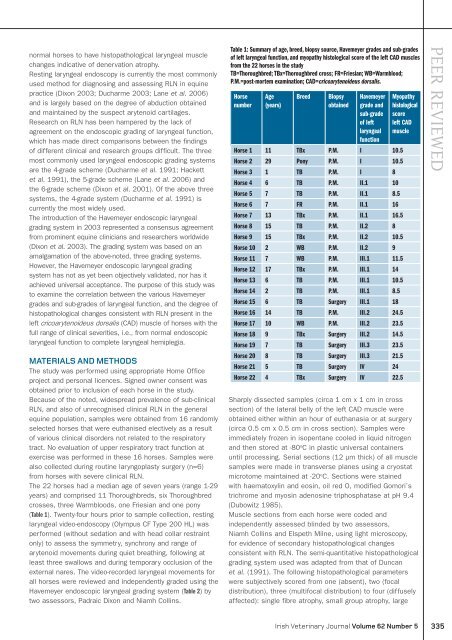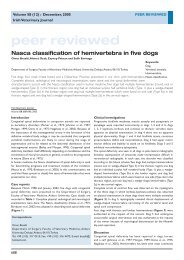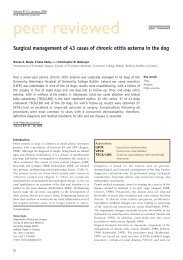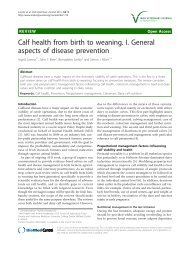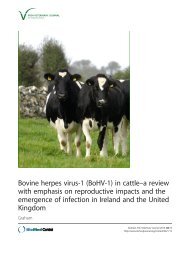Correlation of the Havemeyer endoscopic laryngeal grading system ...
Correlation of the Havemeyer endoscopic laryngeal grading system ...
Correlation of the Havemeyer endoscopic laryngeal grading system ...
Create successful ePaper yourself
Turn your PDF publications into a flip-book with our unique Google optimized e-Paper software.
normal horses to have histopathological <strong>laryngeal</strong> muscle<br />
changes indicative <strong>of</strong> denervation atrophy.<br />
Resting <strong>laryngeal</strong> endoscopy is currently <strong>the</strong> most commonly<br />
used method for diagnosing and assessing RLN in equine<br />
practice (Dixon 2003; Ducharme 2003; Lane et al. 2006)<br />
and is largely based on <strong>the</strong> degree <strong>of</strong> abduction obtained<br />
and maintained by <strong>the</strong> suspect arytenoid cartilages.<br />
Research on RLN has been hampered by <strong>the</strong> lack <strong>of</strong><br />
agreement on <strong>the</strong> <strong>endoscopic</strong> <strong>grading</strong> <strong>of</strong> <strong>laryngeal</strong> function,<br />
which has made direct comparisons between <strong>the</strong> findings<br />
<strong>of</strong> different clinical and research groups difficult. The three<br />
most commonly used <strong>laryngeal</strong> <strong>endoscopic</strong> <strong>grading</strong> <strong>system</strong>s<br />
are <strong>the</strong> 4-grade scheme (Ducharme et al. 1991; Hackett<br />
et al. 1991), <strong>the</strong> 5-grade scheme (Lane et al. 2006) and<br />
<strong>the</strong> 6-grade scheme (Dixon et al. 2001). Of <strong>the</strong> above three<br />
<strong>system</strong>s, <strong>the</strong> 4-grade <strong>system</strong> (Ducharme et al. 1991) is<br />
currently <strong>the</strong> most widely used.<br />
The introduction <strong>of</strong> <strong>the</strong> <strong>Havemeyer</strong> <strong>endoscopic</strong> <strong>laryngeal</strong><br />
<strong>grading</strong> <strong>system</strong> in 2003 represented a consensus agreement<br />
from prominent equine clinicians and researchers worldwide<br />
(Dixon et al. 2003). The <strong>grading</strong> <strong>system</strong> was based on an<br />
amalgamation <strong>of</strong> <strong>the</strong> above-noted, three <strong>grading</strong> <strong>system</strong>s.<br />
However, <strong>the</strong> <strong>Havemeyer</strong> <strong>endoscopic</strong> <strong>laryngeal</strong> <strong>grading</strong><br />
<strong>system</strong> has not as yet been objectively validated, nor has it<br />
achieved universal acceptance. The purpose <strong>of</strong> this study was<br />
to examine <strong>the</strong> correlation between <strong>the</strong> various <strong>Havemeyer</strong><br />
grades and sub-grades <strong>of</strong> <strong>laryngeal</strong> function, and <strong>the</strong> degree <strong>of</strong><br />
histopathological changes consistent with RLN present in <strong>the</strong><br />
left cricoarytenoideus dorsalis (CAD) muscle <strong>of</strong> horses with <strong>the</strong><br />
full range <strong>of</strong> clinical severities, i.e., from normal <strong>endoscopic</strong><br />
<strong>laryngeal</strong> function to complete <strong>laryngeal</strong> hemiplegia.<br />
Materials and methods<br />
The study was performed using appropriate Home Office<br />
project and personal licences. Signed owner consent was<br />
obtained prior to inclusion <strong>of</strong> each horse in <strong>the</strong> study.<br />
Because <strong>of</strong> <strong>the</strong> noted, widespread prevalence <strong>of</strong> sub-clinical<br />
RLN, and also <strong>of</strong> unrecognised clinical RLN in <strong>the</strong> general<br />
equine population, samples were obtained from 16 randomly<br />
selected horses that were euthanised electively as a result<br />
<strong>of</strong> various clinical disorders not related to <strong>the</strong> respiratory<br />
tract. No evaluation <strong>of</strong> upper respiratory tract function at<br />
exercise was performed in <strong>the</strong>se 16 horses. Samples were<br />
also collected during routine laryngoplasty surgery (n=6)<br />
from horses with severe clinical RLN.<br />
The 22 horses had a median age <strong>of</strong> seven years (range 1-29<br />
years) and comprised 11 Thoroughbreds, six Thoroughbred<br />
crosses, three Warmbloods, one Friesian and one pony<br />
(Table 1). Twenty-four hours prior to sample collection, resting<br />
<strong>laryngeal</strong> video-endoscopy (Olympus CF Type 200 HL) was<br />
performed (without sedation and with head collar restraint<br />
only) to assess <strong>the</strong> symmetry, synchrony and range <strong>of</strong><br />
arytenoid movements during quiet breathing, following at<br />
least three swallows and during temporary occlusion <strong>of</strong> <strong>the</strong><br />
external nares. The video-recorded <strong>laryngeal</strong> movements for<br />
all horses were reviewed and independently graded using <strong>the</strong><br />
<strong>Havemeyer</strong> <strong>endoscopic</strong> <strong>laryngeal</strong> <strong>grading</strong> <strong>system</strong> (Table 2) by<br />
two assessors, Padraic Dixon and Niamh Collins.<br />
Table 1: Summary <strong>of</strong> age, breed, biopsy source, <strong>Havemeyer</strong> grades and sub-grades<br />
<strong>of</strong> left <strong>laryngeal</strong> function, and myopathy histological score <strong>of</strong> <strong>the</strong> left CAD muscles<br />
from <strong>the</strong> 22 horses in <strong>the</strong> study<br />
TB=Thoroughbred; TBx=Thoroughbred cross; FR=Friesian; WB=Warmblood;<br />
P.M.=post-mortem examination; CAD=cricoarytenoideus dorsalis.<br />
Horse<br />
number<br />
Age<br />
(years)<br />
Breed<br />
Biopsy<br />
obtained<br />
<strong>Havemeyer</strong><br />
grade and<br />
sub-grade<br />
<strong>of</strong> left<br />
<strong>laryngeal</strong><br />
function<br />
Myopathy<br />
histological<br />
score<br />
left CAD<br />
muscle<br />
Horse 1 11 TBx P.M. I 10.5<br />
Horse 2 29 Pony P.M. I 10.5<br />
Horse 3 1 TB P.M. I 8<br />
Horse 4 6 TB P.M. II.1 10<br />
Horse 5 7 TB P.M. II.1 8.5<br />
Horse 6 7 FR P.M. II.1 16<br />
Horse 7 13 TBx P.M. II.1 16.5<br />
Horse 8 15 TB P.M. II.2 8<br />
Horse 9 15 TBx P.M. II.2 10.5<br />
Horse 10 2 WB P.M. II.2 9<br />
Horse 11 7 WB P.M. III.1 11.5<br />
Horse 12 17 TBx P.M. III.1 14<br />
Horse 13 6 TB P.M. III.1 10.5<br />
Horse 14 2 TB P.M. III.1 8.5<br />
Horse 15 6 TB Surgery III.1 18<br />
Horse 16 14 TB P.M. III.2 24.5<br />
Horse 17 10 WB P.M. III.2 23.5<br />
Horse 18 9 TBx Surgery III.2 14.5<br />
Horse 19 7 TB Surgery III.3 23.5<br />
Horse 20 8 TB Surgery III.3 21.5<br />
Horse 21 5 TB Surgery IV 24<br />
Horse 22 4 TBx Surgery IV 22.5<br />
Sharply dissected samples (circa 1 cm x 1 cm in cross<br />
section) <strong>of</strong> <strong>the</strong> lateral belly <strong>of</strong> <strong>the</strong> left CAD muscle were<br />
obtained ei<strong>the</strong>r within an hour <strong>of</strong> euthanasia or at surgery<br />
(circa 0.5 cm x 0.5 cm in cross section). Samples were<br />
immediately frozen in isopentane cooled in liquid nitrogen<br />
and <strong>the</strong>n stored at -80 o C in plastic universal containers<br />
until processing. Serial sections (12 µm thick) <strong>of</strong> all muscle<br />
samples were made in transverse planes using a cryostat<br />
microtome maintained at -20 o C. Sections were stained<br />
with haematoxylin and eosin, oil red O, modified Gomori’s<br />
trichrome and myosin adenosine triphosphatase at pH 9.4<br />
(Dubowitz 1985).<br />
Muscle sections from each horse were coded and<br />
independently assessed blinded by two assessors,<br />
Niamh Collins and Elspeth Milne, using light microscopy,<br />
for evidence <strong>of</strong> secondary histopathological changes<br />
consistent with RLN. The semi-quantitative histopathological<br />
<strong>grading</strong> <strong>system</strong> used was adapted from that <strong>of</strong> Duncan<br />
et al. (1991). The following histopathological parameters<br />
were subjectively scored from one (absent), two (focal<br />
distribution), three (multifocal distribution) to four (diffusely<br />
affected): single fibre atrophy, small group atrophy, large<br />
PEER reviewed<br />
Irish Veterinary Journal Volume 62 Number 5 335


